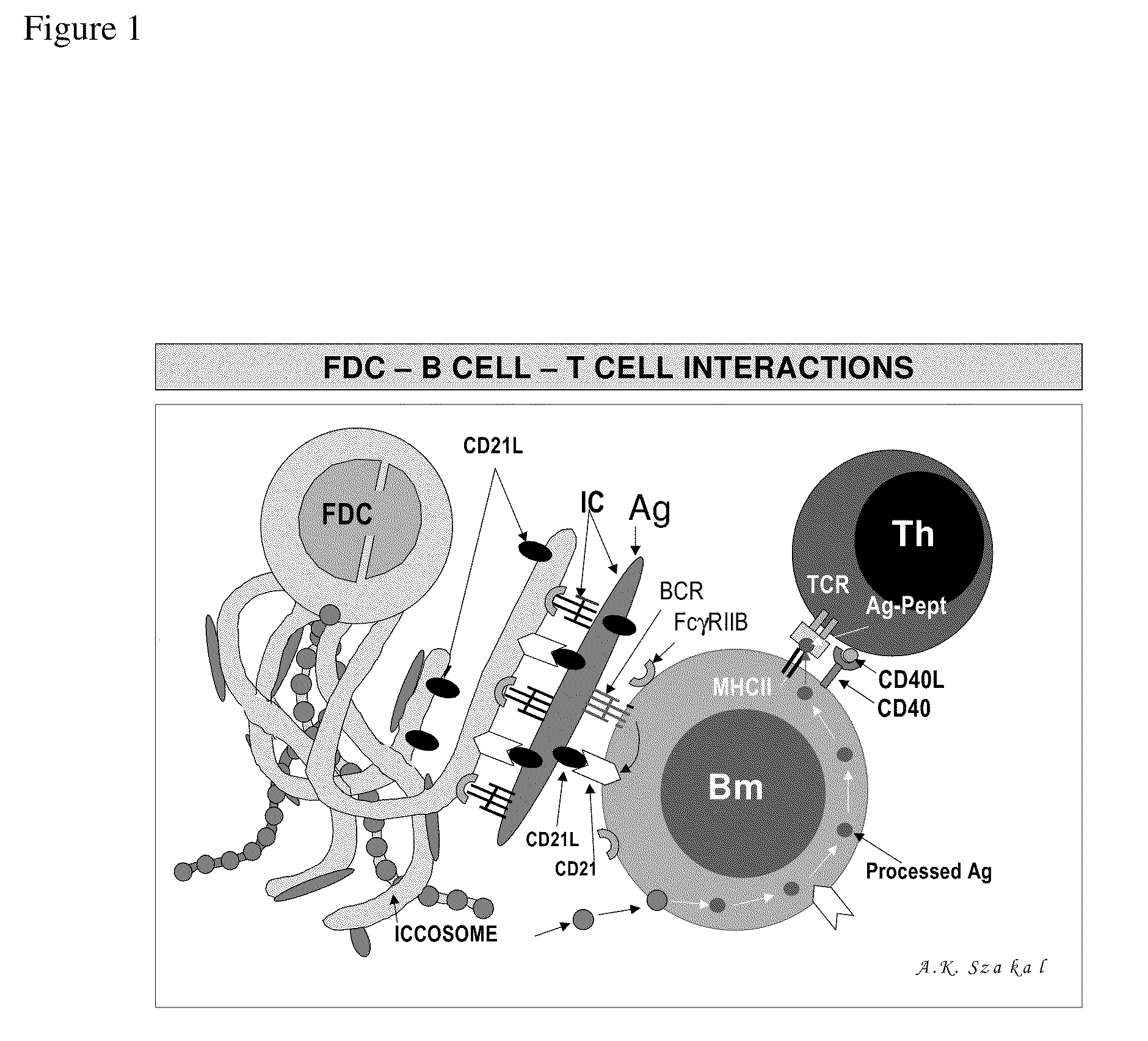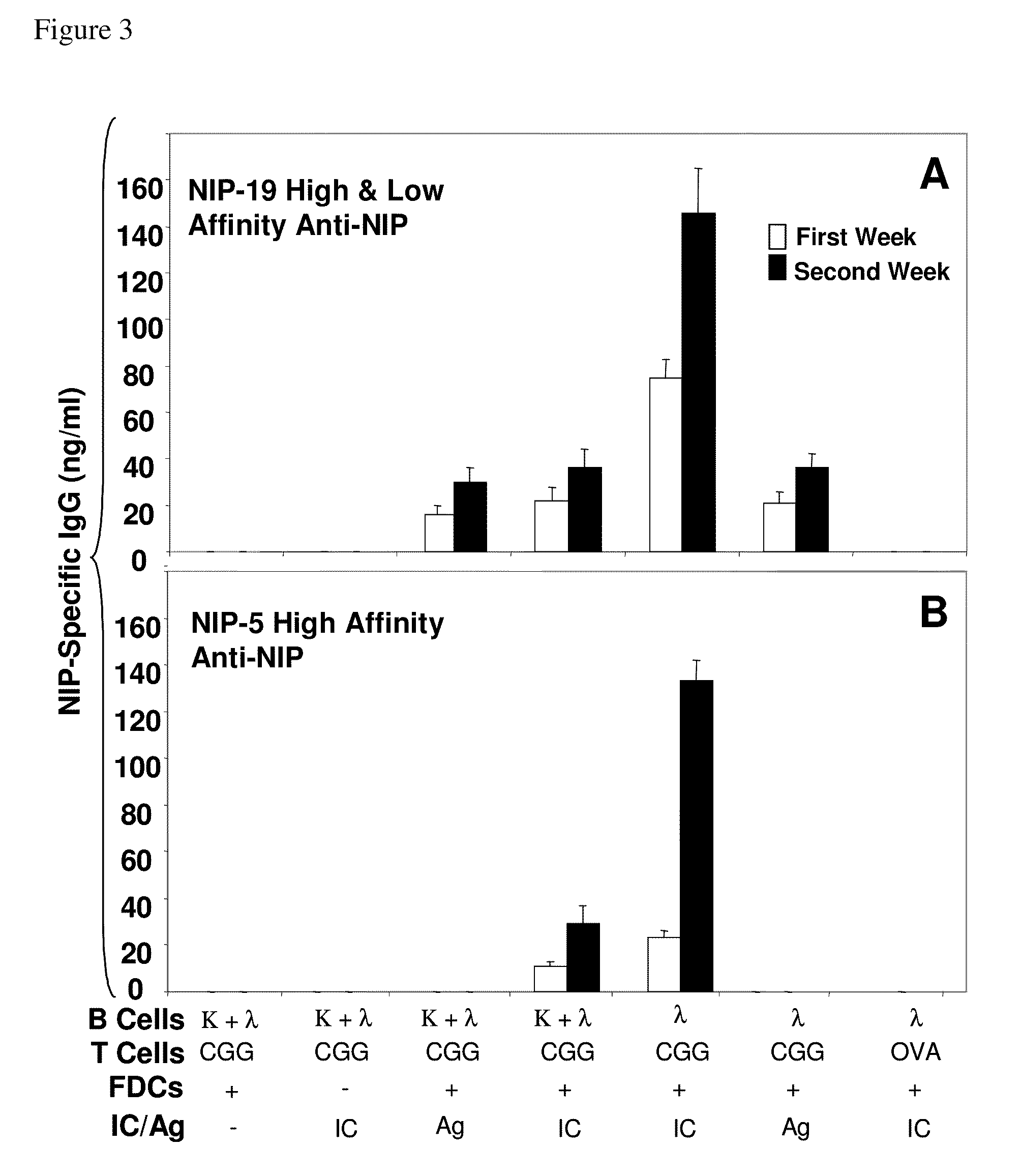In vitro germinal centers
a germinal center and in vitro technology, applied in the field of in vitro germinal centers, can solve the problems of disrupting the organogenesis of lymph nodes, affecting the development of fdc networks, and insufficient for the development of fully functional and mature antibody responses
- Summary
- Abstract
- Description
- Claims
- Application Information
AI Technical Summary
Benefits of technology
Problems solved by technology
Method used
Image
Examples
example 1
[0095]Animals and Immunization. Normal 8 to 12 wk old C57BL / 6 mice can be purchased from the National Cancer Institute (Frederick, Md.) or The Jackson Laboratory (Bar Harbor, Me.). The mice can be housed in standard plastic cages with filter tops and maintained under specific pathogen-free conditions. Food and water can be supplied ad libitum. CGG (chicken gamma globulin)-primed T cells were obtained after immunization with 20 μg CGG (Pel-Freez Biologicals, Rogers, Ark.) and ˜5×108 heat-killed Bordetella pertussis precipitated in aluminum potassium sulfate (A7167, Sigma), as described previously (5, 28). The mice were given a booster immunization 2 weeks later with ˜50 μg CGG i.p. and by ˜5 μg CGG s.c. injection into the front legs and hind footpads.
example 2
[0096]Antibodies and Reagents. Mouse CD45R (B220) MicroBeads, mouse CD90 (Thy1.2) MicroBeads, anti-biotin MicroBeads, and MACS LS columns can be purchased from Miltenyi Biotec GmbH (Auburn, Calif.). Biotin-labeled rat anti-mouse κ can be purchased from Zymed (San Francisco, Calif.). Alkaline phosphatase-labeled goat anti-mouse IgG (H+ L), and alkaline phosphatase-labeled goat anti-mouse IgM can be obtained from, e.g., Kirkegaard & Perry Laboratories (Gaithersburg, Md.). Anti-mouse FDC (FDC-M1) and anti-mouse CD21 / CD35 can be purchased from, e.g., Pharmingen (San Diego, Calif.). NIP19-OVA (4-hydroxy-3-ioda-5-nitrophenylacetyl ovalbumin with 19 NIP groups / OVA), NIP5-OVA (with 5 NIP groups / OVA), and NP30-CGG can be obtained from, e.g., Biosearch Technologies (Novata, Calif.). Rat anti-mouse CD40 can be obtained from, e.g., Southern Biotechnology Associates, Inc. Low-tox-m rabbit complement can be purchased from, e.g., Cedarlane Laboratories Limited (Westbury, N.Y.); heat inactivation w...
example 3
[0097]FDC Isolation. FDCs were isolated from lymph nodes (axillary, lateral axillary, inguinal, popliteal, mesenteric, and paraaortic) of normal, young adult mice as described previously (5, 28). Briefly, one day before FDC isolation the mice were exposed to whole body irradiation to eliminate most T and B cells (1000 rads, using a 137Cs source) (Kosco et al. (1992) J. Immunol. 148, 2331-2339). Lymph nodes were collected and each lymph node capsule was opened using two 26-gauge needles. The lymph nodes were then placed in an enzyme cocktail consisting of 1 ml collagenase D (16 mg / mL, C-1088882, Roche), 0.5 mL DNaseI (5000 units / mL, D-4527, Sigma), and 0.5 mL DMEM, supplemented with 20 mM HEPES, 2 mM glutamine, 50 μg / mL gentamicin, and MEM non-essential amino acids (GIBCO). After 30 min at 37° C. in a CO2 incubator, the medium and released cells were removed and transferred to a 15 mL conical centrifuge tube containing 5 mL DMEM with 20% FCS and placed on ice. The remaining tissue wa...
PUM
 Login to View More
Login to View More Abstract
Description
Claims
Application Information
 Login to View More
Login to View More - R&D
- Intellectual Property
- Life Sciences
- Materials
- Tech Scout
- Unparalleled Data Quality
- Higher Quality Content
- 60% Fewer Hallucinations
Browse by: Latest US Patents, China's latest patents, Technical Efficacy Thesaurus, Application Domain, Technology Topic, Popular Technical Reports.
© 2025 PatSnap. All rights reserved.Legal|Privacy policy|Modern Slavery Act Transparency Statement|Sitemap|About US| Contact US: help@patsnap.com



